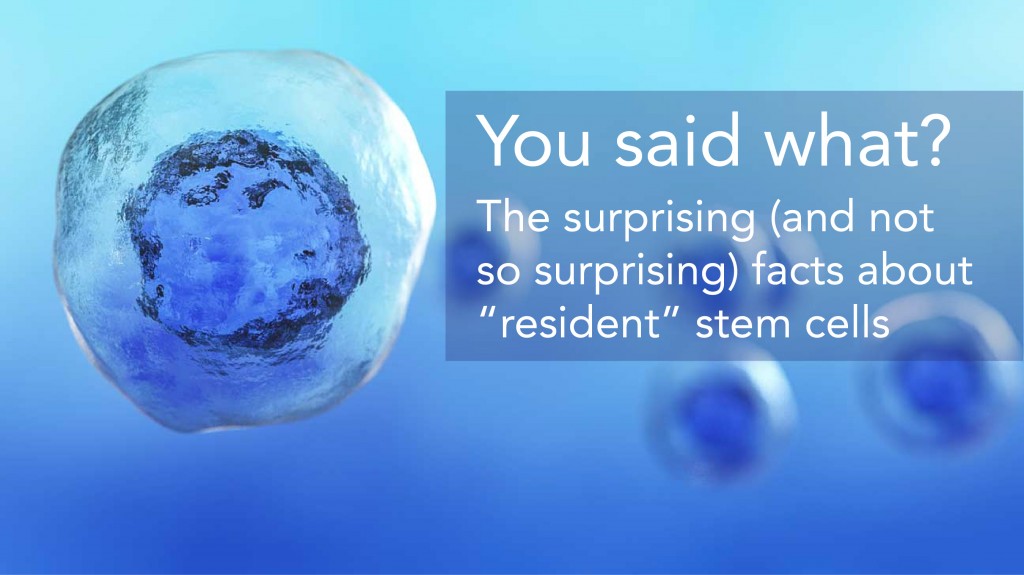What purpose do resident stem cells serve in the body? This is a fair but yet complicated question as our knowledge has only reached the “tip of the iceberg” with stem cell biology. Previously we have discussed adult stem cells, their use as a therapy, and made mention of the recruitment of resident stem cells to a site of injury. But what do we know about the stem cells that reside in the numerous tissues of the body? In today’s blog, we will explore the current scientific knowledge of resident stem cells, what they do (and do not do) and uncover some little facts that might even surprise you!
1. What are resident stem cells?
Every individual (both two legged and four legged) has stem cells residing in their tissues and organs. Also referred to as adult stem cells, these cells are characterized by two very important attributes1:
1. Self- renewal: the ability to divide without differentiation
2. Multipotency: the capacity to specialize in different cell types
2. Where can these resident stem cells be found?
Almost every tissue in the body has resident stem cells housed in what is called a “stem cell niche”. This niche is generally understood to be a “micro-environment” where stem cells reside and where they receive signals from other cells in the body to activate, self-renew or remain dormant2.Stem cell niches can be equated to an operator providing assistance. They receive “calls” from the tissue, direct the message to the appropriate “department” (stem cell) and determine the action that is needed for resolution (“pick up the call”-stem cell to activate/ differentiate, “set up meeting”- self renew or “send to voicemail”- stay dormant).
- Bone Marrow
- Adipose
- Brain
- Peripheral Blood
- Blood Vessels
- Skeletal Muscles
- Skin
- Teeth
- Hair
- Gut
- Liver
- Reproductive Tissues
3. What purpose do resident stem cells serve in the body?
The primary role of resident stem cells is to maintain and repair the tissue in which they are found1. As discussed above, these stem cells are signaled through their niche to differentiate and respond to the area of damage.
4. Why are degenerative conditions and injuries treated with platelet rich plasma and stem cell therapies if resident stem cells are already present near the injured tissue?
Chronic conditions such as arthritis and DJD have a multitude of factors that contribute to the progression of the disease, many of which are beyond the scope of this blog. While stem cells may be located near the area of injury, there are several reasons why they may not be renewing the damaged cells in the tissue. Hypothesized reasons for this include:
1. Resident stem cells make up a very small number of cells in each tissue3. In the instance of a degenerative disease, the rate at which cells are replenished through resident stem cells can be suboptimal compared to what is necessary to fully repair the tissue. This constant demand for “repair mode” may also lead to the exhaustion of the regenerative potential of the tissue2.
2. As the body ages, so do the communication pathways between the tissues and the resident stem cells. These communication pathways, which are influenced by growth factors, can become disrupted or dysregulated, which can lead to slowed/halted renewal (stem cells stay dormant and/or limited in numbers) or unregulated production (ex. cancer)2.Regenerative medicine shows great promise in benefiting tissues where these communication pathways and imbalances are present. Platelet Rich Plasma provides beneficial growth factors which aid in the recruitment of resident stem cells while stem cell treatments have the potential to restore tissue homeostasis and structure.
5. What tissues have resident stem cells?
In the early days of research, few tissues were thought to have stem cells, which included bone marrow, fat, skin and muscle. Now, that list has grown exponentially to encompass1:
While more research is needed to fully understand the functions and purpose of resident stem cells, it is easy to see they are an important part of tissue biology and diseases. Stay tuned for our next blog where we will travel back in time to the early years of regenerative medicine!
1. NIH Stem Cell Information Home Page. In Stem Cell Information [World Wide Web site]. Bethesda, MD: National Institutes of Health, U.S. Department of Health and Human Services, 2016 [cited August 15, 2017] Available at < //stemcells.nih.gov/info/basics/7.htm>
2. Adv Exp Med Biol. 2010 ; 695: 155–168. doi:10.1007/978-1-4419-7037-4_11.
3. Adult mesenchymal stem cells and cell-based tissue engineering. R.S.Tuan, G. Boland and R.Tuli Arthritis Res Ther. 20025:32. https://doi.org/10.1186/ar614© BioMed Central Ltd 2003




